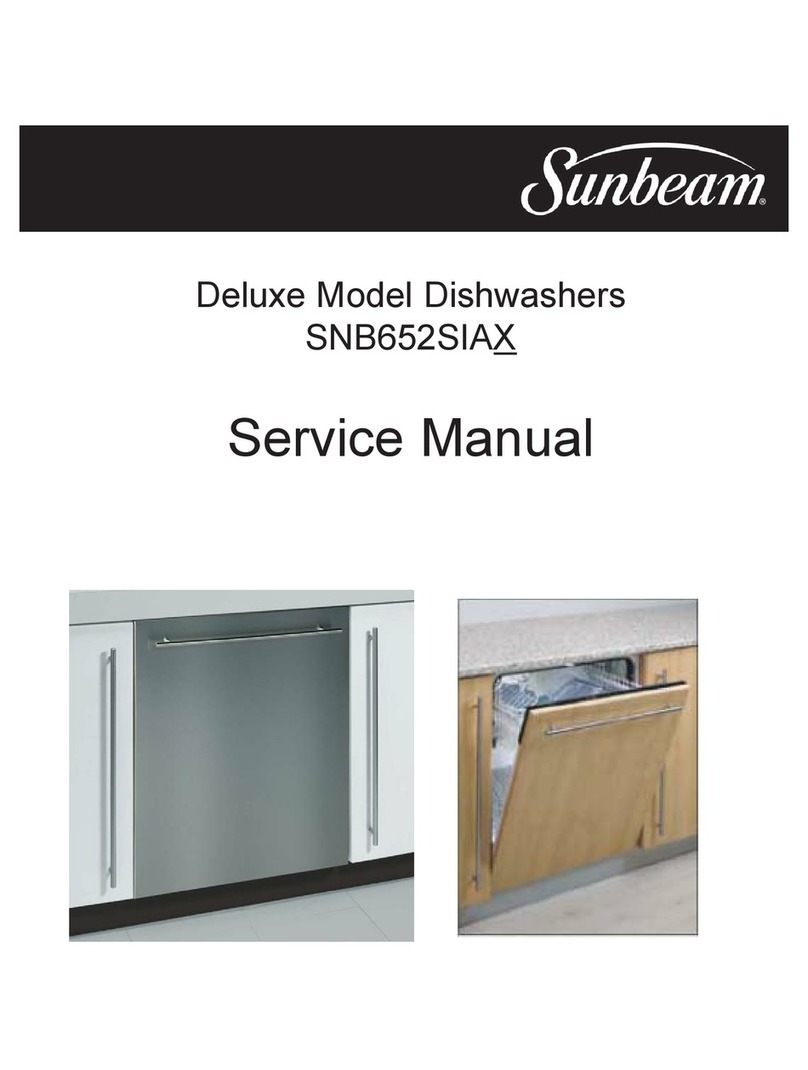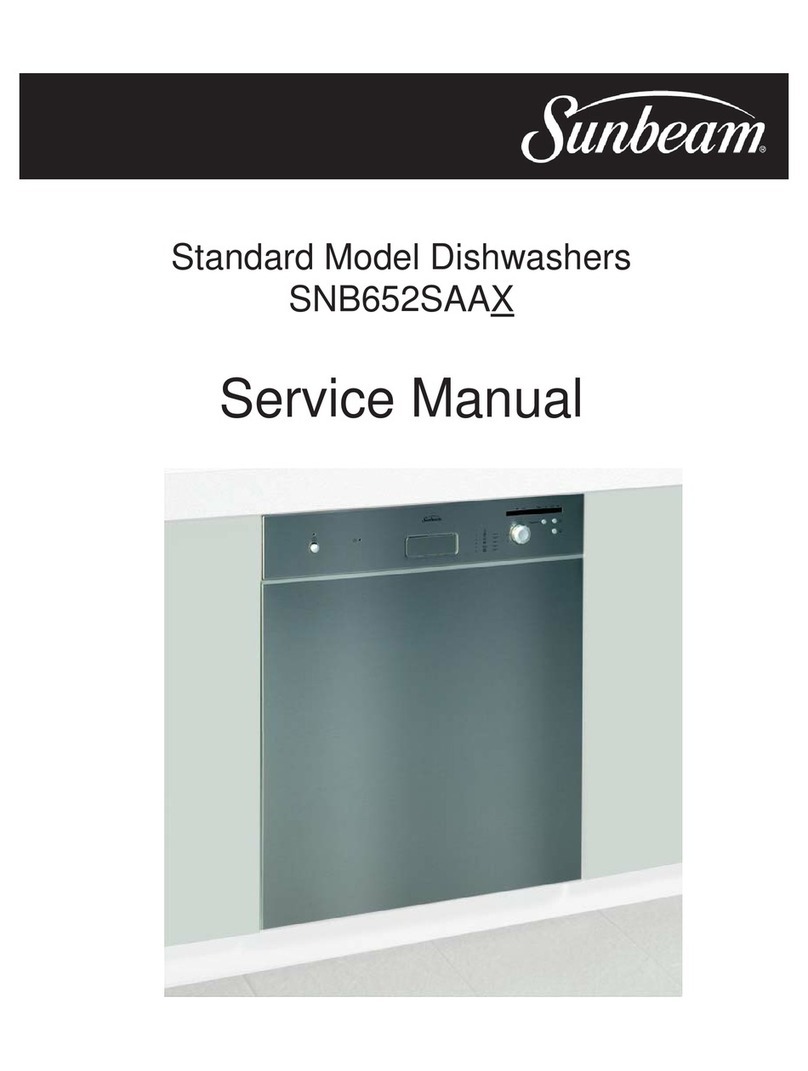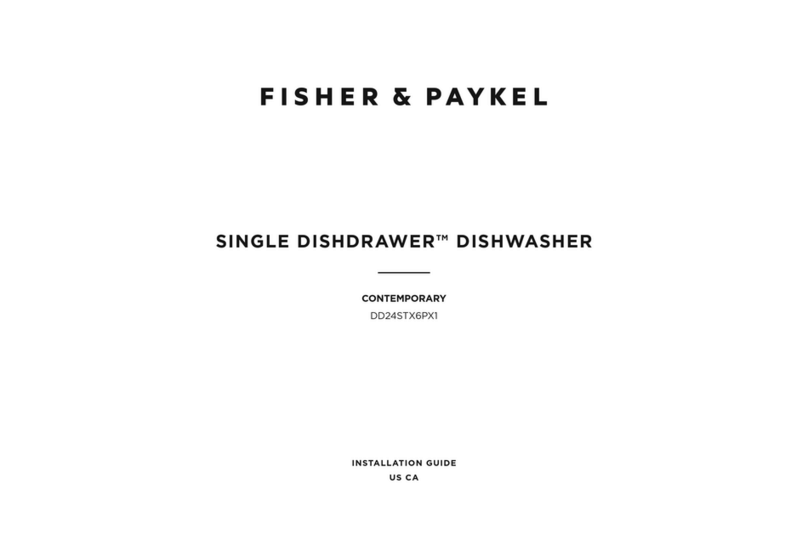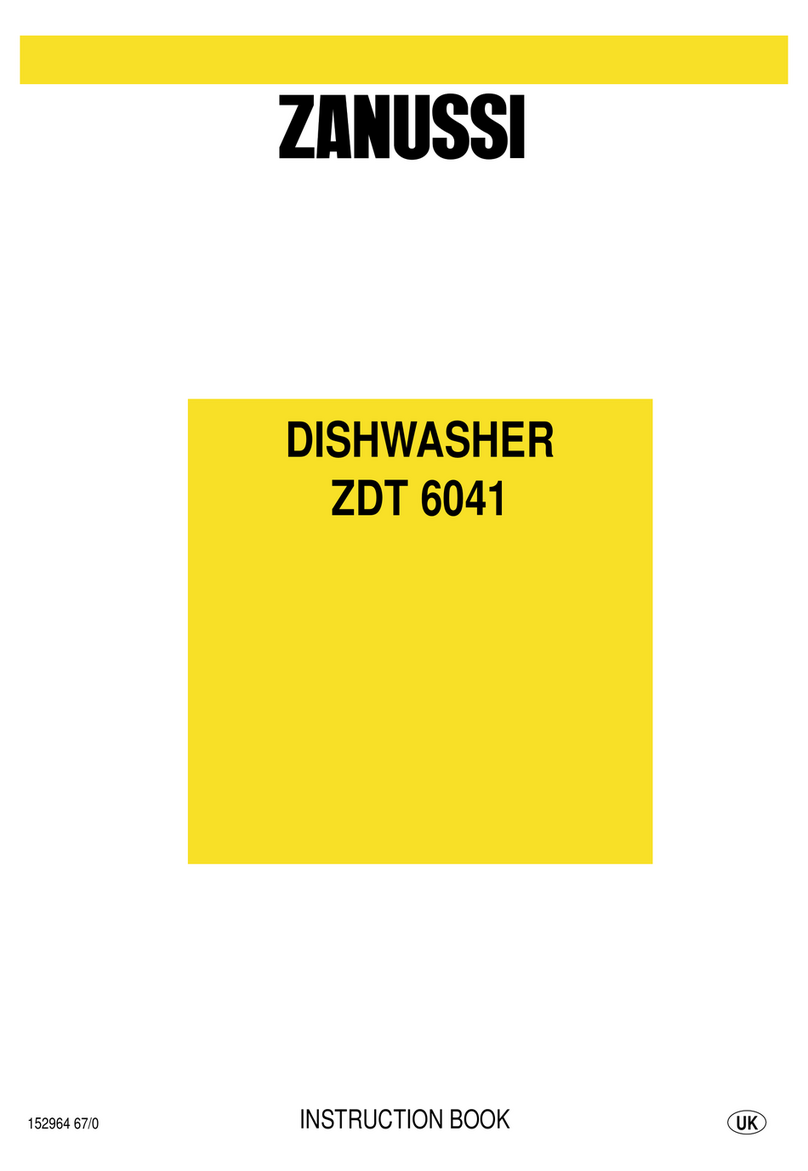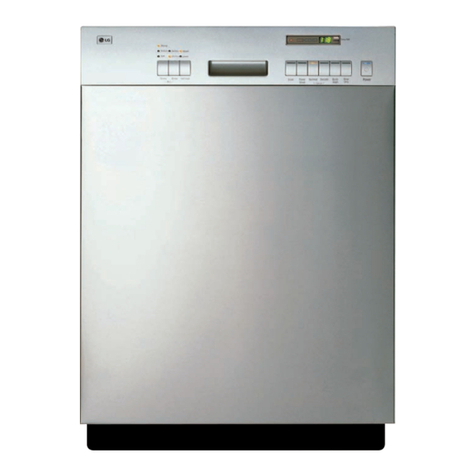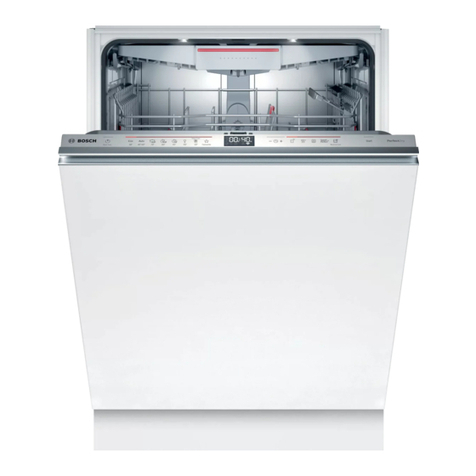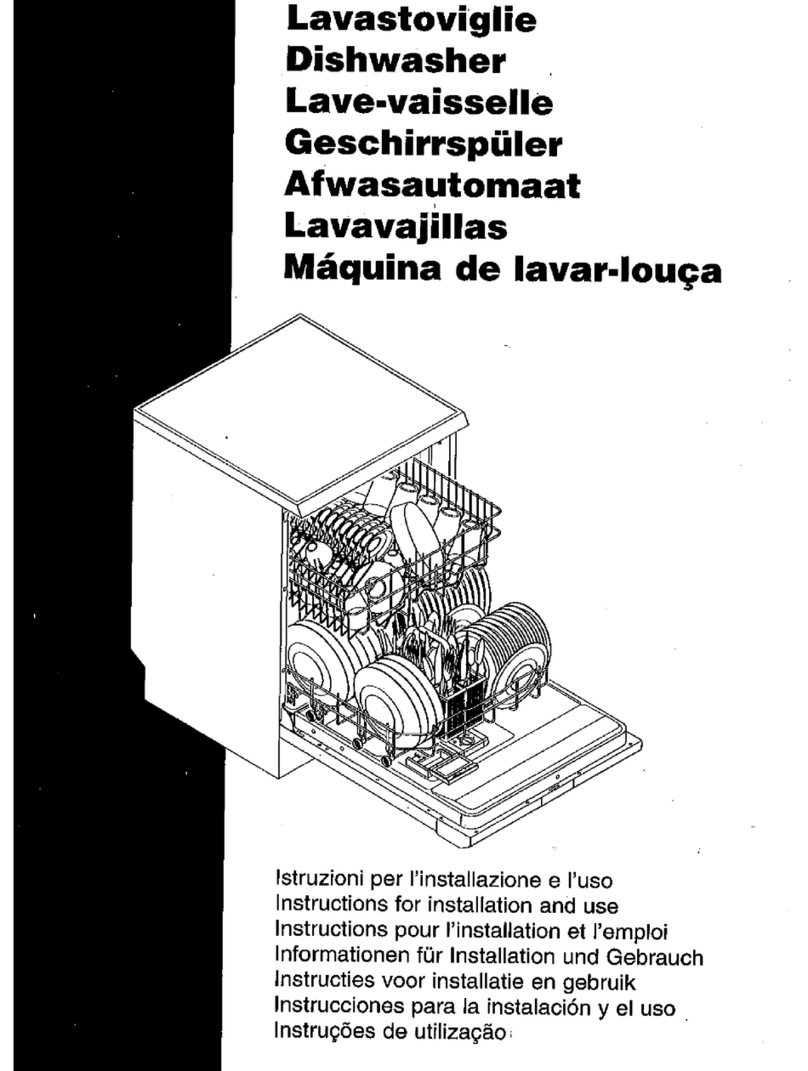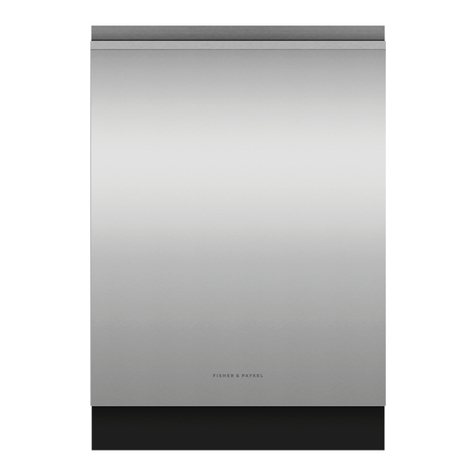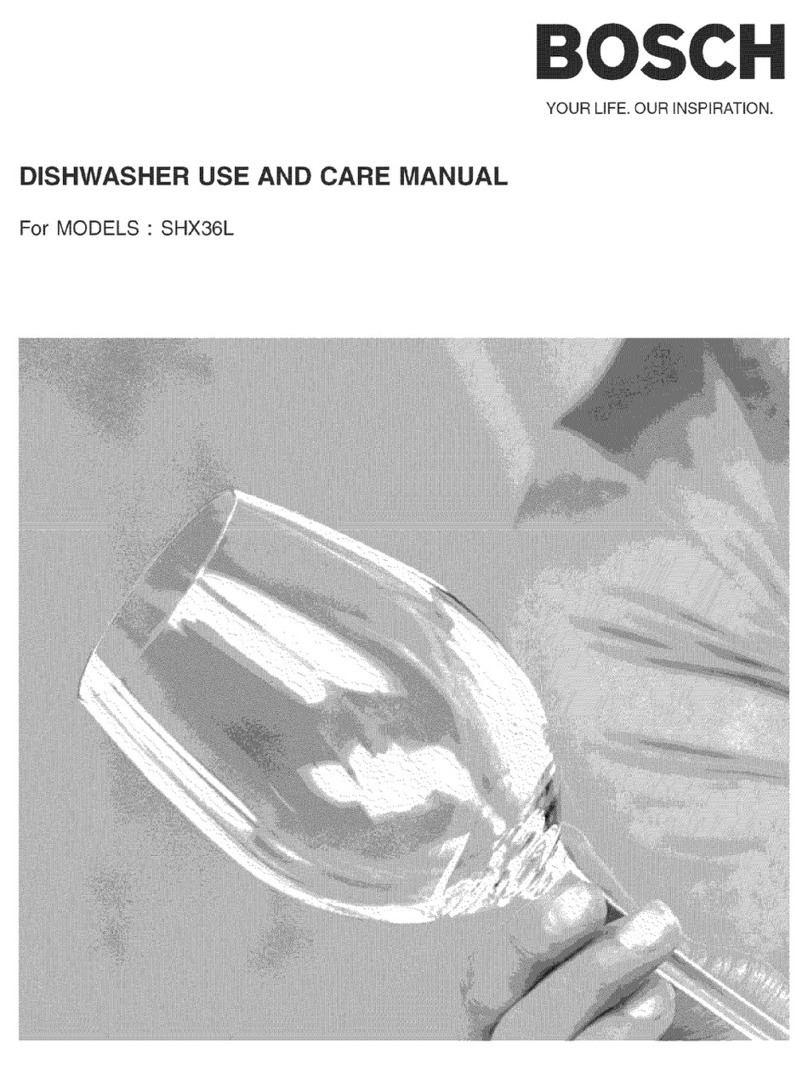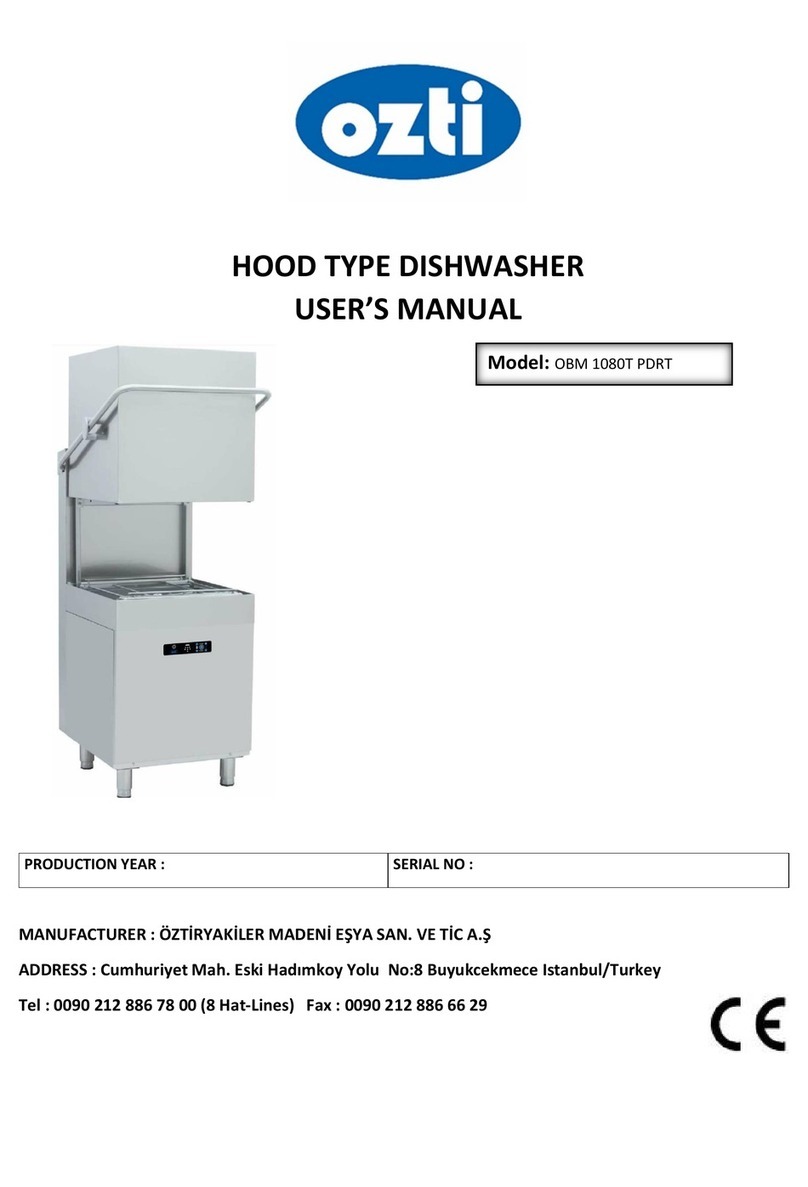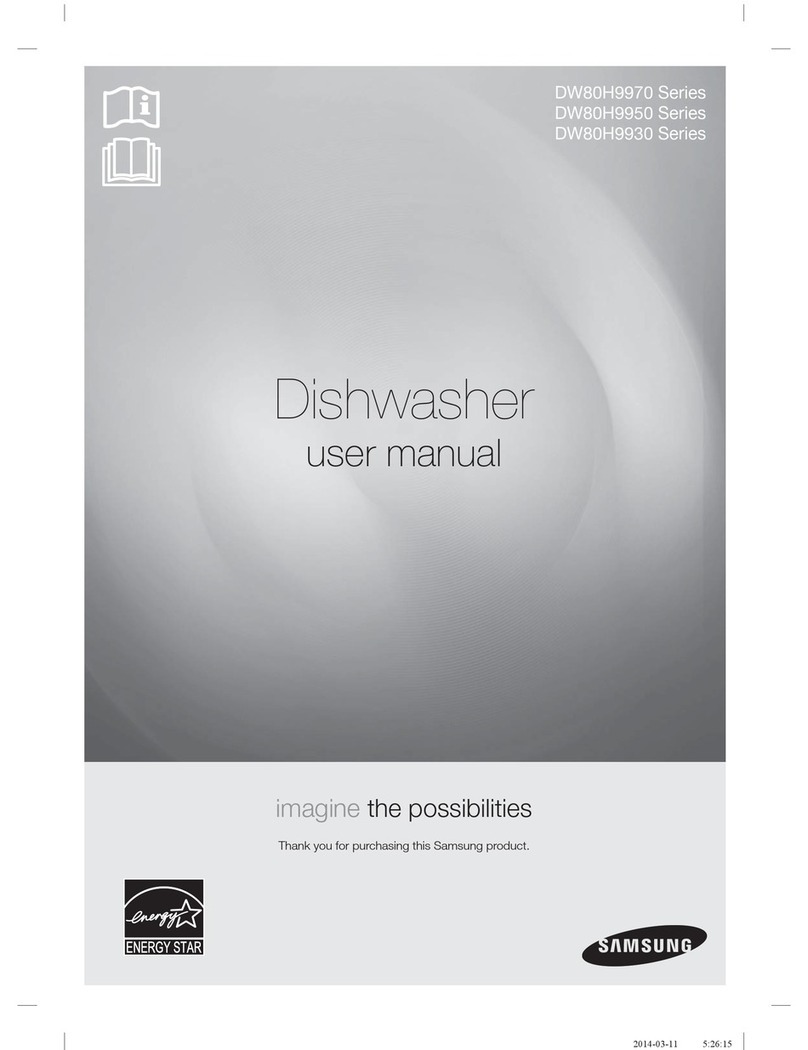Sunbeam DWSB3607WW User manual

DWSB3607WW
DWSB3607BB
DWSB3607RR

Dear Customer,
Please carefully read this manual before using the dishwasher.
It will help you to use and maintain the dishwasher properly.
Pass it on to any subsequent owner of the appliance.
This manual contains sections of Safety Instructions,
Operating Instructions, Installation Instructions and
Troubleshooting Tips, etc.
The manufacturer, following a policy of constant
development and updating of the product, may make
modifications without giving prior notice.
Keep it to refer to at a later date.
If you can not resolve the problems by yourself,
please call Customer Service 1-855-877-4085.
Review the section on Troubleshooting Tips to
solve common problems.
Dishwasher Features............................................
Filtering System...................................................
Caring for the Dishwasher.....................................
Filling the Rinse Aid Dispenser..............................
Function of Detergent...........................................
Loading the Baskets..............................................
Cutlery Basket.....................................................
Wash Cycle Table.................................................
Turning on the Appliance......................................
Changing the Wash Cycle.....................................
At the End of the Wash Cycle.................................
Positioning the Appliance.....................................
Water Connection................................................
About Power Connection......................................
Connection of Drain Hoses...................................
Starting the Dishwasher........................................
Before Calling for Service......................................
Error Codes.........................................................
Technical Information..........................................
Control Panel.......................................................2
Utensil Guide........................................................
Forget to Add a Dish?...........................................
Installation Preparation........................................
Recommendations................................................
Attention Before or After Loading the Dishwasher
Baskets ...............................................................
3
4
6
6
6
8
9
9
10
10
13
17
19
18
16
16
14
14
14
12
11
10
7
2

GROUNDING INSTRUCTIONS
1
When using your dishwasher, follow the precautions listed below:
Keep children away from detergent and rinse aid, keep
child away from the open door of the dishwasher,
there could still be some detergent left inside.
ren
Do not abuse, sit on, or stand on the door or dish
rack of the dishwasher.
Do not touch the heating element during or
immediately after use.
(This instruction is only applicable to machines
with a visual heating element.)
Do not wash plastic items unless they are marked
dishwasher safe or the equivalent. For plastic items
not so marked, check the manufacturer's
recommendations.
Use only detergent and rinse additives
designed for an automatic dishwasher.
Never use soap, laundry detergent, or hand
washing detergent in your dishwasher. Keep
these products out of the reach of children.
During installation, the power supply must not
be excessively or dangerously bent or flattened.
The door should not be left in the open position
since this could present a tripping hazard.
Do not tamper with controls.
Do not place any heavy objects or stand on the
door when it is open. The appliance could tip
forward.
When loading items to be washed:
2 Knives and other utensils with
sharp points must be loaded in the basket
with their points down or placed in a
horizontal position.
1) Secure sharp items so that they are not
likely to damage the door seal.
)WARNING:
When using your dishwasher, you should
prevent plastic items from coming into contact
with heating element. (This instruction is only
applicable to machines with a visual heating
element.)
If the supply cord is damaged, it must be replaced
by the manufacturer or its service agent or a
similarly qualified person in order to avoid a
hazard.
Please dispose of packing materials properly.
Use the dishwasher only for its intended function.
Remove the door to the washing compartment when
removing an old dishwasher from service or discarding
it.
Dishwasher detergents are strongly alkaline, they
can be extremely dangerous if swallowed. Avoid
contact with skin and eyes and keep children away
from the dishwasher when the door is open.
Check that the detergent is empty
after completion of the wash cycle.
receptacle
The appliance is to be connected to the water
mains using new hose sets and old hose-sets
should not be reused.
Children should be supervised to ensure that they do
not play with the appliance.
This appliance is not intended for use by persons
(including children with reduced physical, sensory or
mental capabilities, or lack of experience and
knowledge, unless they have been given supervision
or instruction concerning use of the appliance by a
person responsible for their safety.
)
Do not operate your dishwasher unless all
enclosure panels are properly in place. Open
the door very carefully if the dishwasher is
operating, there is a risk of water squirting out.
This appliance must be grounded. In the event of a
malfunction or breakdown, grounding will reduce
the risk of electric shock by providing a path of
least resistance of electric current. This appliance
is equipped with a cord having an equipment-
grounding conductor and a grounding plug.
The plug must be plugged into an appropriate outlet
that is installed and grounded in accordance with
all local codes and ordinances.
Improper connection of the equipment-grounding
conductor can result in a risk of electric shock.
Check with a qualified electrician or service
representative if you are in doubt whether the
appliance is properly grounded. Do not modify the
plug provided with the appliance; If it is not fit for
the outlet. Have a proper outlet installed by a
qualified electrician.
READ ALL INSTRUCTIONS BEFORE USING AND SAVE FOR FUTURE REFERENCE.
The maximum number of place settings to be
washed is 6.
The maximum permissible inlet water pressure is
1Mpa.
The minimum permissible inlet water pressure is
0.04Mpa.
WARNING: PROPER USE

2
before using it for the first time.
To get the best performance from your dishwasher, read all operating instructions
3
5
7 8 9
Filter AssemblyBasket Rinse Aid Dispenser Inlet Pipe Connector
Detergent Dispenser
3
6
Cutlery Basket
5
8
Spray Arms
7Drain Pipe
Connector
9
Cup Shelf
1
2 4
1
2 4 6
5
2
3
4
6
Power Button: To turn on/off the power supply.
Wash Cycle Selector: Press the button
to select wash cycles.
Cycle Indicator Light.
Delay Button: Press the button to delay.
Start/Pause Button: Press this button to start
or pause the dishwasher.
Rinse aid function indicator
.
7Cycle ending indicator
32
4
WQP6-3607-US
IMPORTANT

3
The rinse aid is released during the final rinse to prevent water from forming droplets on your dishes. That can leave
spots and streaks. It also improves drying by allowing water to sheet off the dishes. Your dishwasher is designed to
use liquid rinse aids. The rinse aid dispenser is located inside the door next to the detergent dispenser. To fill the
dispenser, open the cap and pour the rinse aid into the dispenser until the level indicator turns completely black.
The volume of the rinse aid container is about 3.7 ounces.
Rinse Aid Dispenser
Function of Rinse Aid
Rinse aid is automatically added during the last rinse, ensuring thorough rinsing, and spot and streak free drying.
As the rinse aid diminishes, the size of the black dot
on the rinse aid level indicator changes, as illustrated below.
Full
3/4 full
1/2 full
1 full - Should refill to eliminate spotting
Empty
/4
Rinse Aid Indicator
When to Refill the Rinse Aid Dispenser
If there is no rinse aid warning light in the control panel, you can judge the amount of rinse aid by the color
of the optical level indicator located next to the cap. When the rinse aid container is full, the whole
indicator will be dark. As the rinse aid diminishes, the size of the dark dot decreases. You should never let
the rinse aid get below1/4 full.
Attention!
Only use branded rinse aid for dishwasher. Never fill the rinse aid dispenser with any other substances (e.g. Dishwasher
cleaning agent, liquid detergent). This would damage the appliance.
To open the dispenser, turn the cap to the "open" (left) arrow and lift it out.
Pour the rinse aid into the dispenser, being careful not to overfill.
Replace the cap by inserting it aligned with "open" arrow and turning it to the closed (right) arrow.
1
2
3
Clean up any rinse aid spilled during filling with an absorbent cloth to avoid excessive foaming during the
next wash.
Don't forget to replace the cap before you close dishwasher door.

4
Detergents with its chemical ingredients are necessary to remove dirt and transport it out of the dishwasher.
and dry.
Don't put powder detergent into the dispenser until you're ready to wash dishes.
Use only detergent specifically made for use in dishwashers. Keep your detergent fresh
Proper Use of Detergent
Adjusting Rinse Aid Dispenser
The rinse aid dispenser has four settings. The recommended setting is "3".
If the dishes still are not drying properly or are spotted, adjust the dial to the
next highest level "4".
Increase the dose if there are drops of water or lime spots on the dishes after washing. Reduce
it if there are sticky whitish stains on your dishes or a bluish film on glassware or knife blades.
Based on their chemical composition, detergent can be split in two basic types:
The use of normal washing cycles in conjunction with concentrated detergents reduces pollution and is good for
your dishes; these wash cycles are specially matched to the dirt-dissolving properties of the enzymes of the
concentrated detergent. For this reason wash cycles in which concentrated detergents are used can achieve
the same
“ ”
Detergent tablets of different brands dissolve at different speeds. For this reason some detergent tablets cannot
dissolve and develop their full cleaning power during short wash cycles. Therefore please use long wash cycles when
using detergent tablets, to ensure the complete removal of detergent residuals.
Concentrated Detergent
Detergent Tablets
conventional, alkaline detergents with caustic components
low alkaline concentrated detergents with natural enzymes
Detergent tablets are only for the models with 3 in 1 function or 3 in 1 cycle.
“ ”normal
results that can otherwise only be achieved using heavy cycle.“ ”

Amount of Detergent to Use
The dispenser must be refilled before the start of each wash cycle following the instructions provided in the Wash Cycle
Table. Your dishwasher uses less detergent and rinse aid then conventional dishwasher. Generally, only one
tablespoon of detergent is needed for a normal wash load. Also, more heavily soiled items need more detergent.
Always add the detergent just before starting the dishwasher, otherwise it could get damp and will not dissolve
properly.
Detergent Dispenser
If the lid is closed: press release button. The lid springs open.
Always add the detergent just before starting each wash cycle.
Only use branded detergent aid for dishwasher.
5
Detergent tablet
Detergent powder
Fill the detergent dispenser with detergent.
The marking indicates the dosing levels, as
illustrated on right:
The d can load 0.5 ounces detergent.etergent dispenser
The d can load 0.9 ounces detergent.etergent dispenser
Please observe the manufacturers dosing and storage
recommendations as stated on the detergent packaging.
Close the lid and press until it locks in place.
If the dishes are heavily soiled, place an additional
detergent dose in the pre-wash detergent chamber. This detergent will take effect during the pre-wash phase.
A.
Filling the Detergent Dispenser
Refer to information about the amount of detergent for single wash cycles on page 9.
Please be aware, that according to the level of soiling and specific hardness of water differences are possible.
Please observe the manufacturer's recommendations on the detergent packaging.
Dishwasher detergent is corrosive! Take care to keep it out of reach of children.
B.

6
Cutlery with wooden, horn china or
mother-of-pearl handles
Plastic items that are not
Older cutlery with glued parts that are not
temperature resistant
Bonded cutlery items or dishes
Pewter or copper items
Crystal glass
Steel items subject to rusting
Wooden platters
Items made from synthetic materials
heat resistant
Some types of glasses can become
dull after a large number of washes
Silver and aluminium parts have a
tendency to discolor during washing
Glazed patterns may fade if machine
washed frequently
Are not suitable: Are of limited suitability:
To prevent damage, do not take glass and cutlery out of the dishwasher immediately after the
has ended.
Consider buying utensils which are identified as dishwasher-safe.
wash cycle
Load hollow items such as cups, glasses, pans etc. with the opening downwards so that water cannot collect in the
container or a deep base.
Dishes and items of cutlery must not lie inside one another, or cover each other.
To avoid damage to glasses, they must not touch.
Load large items which are most difficult to clean into the basket.
Long bladed knives stored in an upright position are a potential hazard!
Long and/or sharp items of cutlery such as carving knives must be positioned horizontally in the basket.
Please do not overload your dishwasher. This is important for good results and for reasonable energy usage.
For best performance of the dishwasher, follow these loading guidelines.
Features and appearance of baskets and cutlery baskets may vary from your model.
Scrape off any large amounts of leftover food. Soften remnants of burnt food in pans.
It is not necessary to rinse the dishes under running water.
Place objects in the dishwasher in following way:
1. Items such as cups, glasses, pots/pans, etc. are face down.
2. Curved items, or those with recesses, should be loaded at a slant so that water can run off.
3. All utensils are stacked securely and can not tip over.
4. All utensils are placed in the way that the spray arms can rotated freely during washing.
Very small items should not be washed in the dishwasher as they could easily fall out of the basket.

7
Position the dishes and cookware so that they will not get moved by the spray of water.
Plate Racks of Basket
The basket is fitted with plate racks which
can be stowed horizontally if required.
Saucers
4
Serving Bowl
3
Glasses
1
Cups
6
Oval Platter
7
Dinner Plates Bread and
Butter Plates
8
Fruit Bowl
5
Cutlery Basket
9
2
5
1
1
6

8
Cutlery should be placed in the cutlery basket with handles at the bottom. If the rack has side baskets, the spoon
should be loaded individually into the appropriate slots, especially long utensils should be placed in the horizontal
position at the front of the upper basket as shown.
Do not let any item extend through bottom.
Always load sharp utensils with the sharp point down.
For personal safety and a top quality clean, place the silverware in the basket:
Make sure cutlery does not nest together.
Place silverware with handles down.
Place knives and other potentially dangerous utensils handles up.
Teaspoons
3
Dinner Forks
1
Serving Forks
6
Serving Spoons
5
Knives
4
Salad Forks
2

9
Means: need to fill rinse into the rinse aid dispenser.
( )
*AHAM DW-1-2005: This program is the test cycle, the rinse aid dispenser setting is recommended to Position 3.
Starting a wash cycle:
1. Draw out the basket (see the section titled "Loading the Dishwasher Baskets").
2. Pour in the detergent (see the section titled "Function of Detergent" and "Filling the Rinse Aide Dispenser").
3. Insert the plug into the socket. The power supply is 120V/60Hz.
4. Make sure that the water supply is turned on to full pressure.
5. Close the door and p
6.
ress the button t .
Press the program button to select wash program you need
7.Then press the Start/Pause button, the dishwasher will start.
on/off o turn on the power supply
Heavy->Normal->ECO->Glass->Speed->Rinse
When you press the Start/Pause button to pause during washing, the display time will stop blinking and the
cycle will pause and remain this cycle till you restart it again.
For normally soiled loads,
such as pots, plates, glasses
and lightly soiled pans.
Standard daily cycle.
For the heaviest soiled loads,
such as pots, pans, casserole
dishes and dishes that have
been sitting with dried food
on them for a while.
A shorter wash for lightly
soiled loads that do not
need drying.
For lightly soiled loads,
such as glasses, crystal and
fine china.
0.5oz
110
100
45
75
0.36
0.49
0.31
0.27
Pre-wash
Pre-wash
Wash
Rinse
Rinse
Drying
Pre-Wash
Pre-Wash
Wash
Rinse
Rinse
Drying
N/A
24
0.03
Pre-wash
Main-wash
Wash
Rinse
Pre-wash
Pre-wash
Rinse
Pre-wash
Wash
Pre-wash
Wash
Rinse
Rinse
Drying
ECO
0.6oz
0.6oz
0.6oz
Use for rinsing dishes,
glasses and silverware
that will not be washed right
away.
Speed
(* AH AM DW-1-2005)
Normal
Heavy
Rinse
For lightly soiled
and glass.
dishes
70 0.28
Pre-Wash
Wash
Rinse
Rinse
Drying
0.5oz
Glass
Program
Information

It is dangerous to open the door , because the hot water may scald you.mid-cycle
When the cycle has finished, the buzzer of dishwasher will sound 8 seconds, then stop. Turn off the appliance
using the On/Off button, shut off the water supply and open the door of the dishwasher.
Since the appliance is on standby, it will power off after 30 minutes
without any operation.
Wait a few minutes before
unloading the dishwasher to avoid handling the dishes and utensils while they are still hot and more susceptible to
breakage. They will also dry better.
wash
automatically
Turn Off the Dishwasher
1. Switch off the dishwasher by pressing the ON/OFF button.
2. Turn off the water tap.
All panel lights should be off, indicating the cycle has ended.
Open the Door Carefully
Hot dishes are The dishes should therefore be allowed to cool down around 15 minutes
before removing from the appliance.
Open the dishwasher's door, leave it ajar and wait a few minutes before removing the dishes. Dishes will be cooler
and drying will be improved.
susceptible to breakage.
Unloading the Dishwasher
It is normal that the dishwasher is wet inside.
10
A forgotten dish can be added any time before the detergent cup opens.
Add forgotten dishes.
Close the door.
After the spray arms stop moving, you can open the door
completely.
2
3
Open the door to stop the washing.carefully
1 4
5
6
Premise: You can still modify the wash cycle if the cycle has just started. If cycle has begun the
detergent may have already been released and the appliance may have already drained the wash
water. If this is the case, the detergent dispenser must be refilled.
(See the section titled "Filling the Rinse Aide Dispenser").
To change the , press
machine will be in standby mode, then you can change the program to the desired cycle setting.
See the section entitled Starting a Wash Cycle.
.....................................
b) The display shows no blinking lights ...........On pause.
the
a) All phase lights off On standby.
wash cycle program selector button for more than three seconds and the
The lights indicate the program/cycle phase.
c) The display shows blinking lights ............... Running.
Press the Start/Pause button.
Press the Start/Pause Button and the dishwasher will
after 10 seconds.
resume
If you open the door mid-cycle, the machine will pause.When you close the door, press Start/Pause to resume cyele.

11
The filter prevents larger remnants of food or other objects from getting inside the pump.
The filter system consists of a coarse filter, a mflat ( ain filter)
and a micro filter (fine filter).
Food and soil particles trapped by this filter are pulverized by a
special jet on the spray arm and washed down the drain.
Main filter
A
Larger items, such as pieces of bone or glass, that could block
the drain are trapped in the coarse filter. To remove the items
caught by the filter, gently squeeze the tap on the top of this
filter and lift out.
Coarse filter
C
This filter holds soil and food residue in the sump area and
prevents it from being deposited on the dishes during wash cycle.
Fine filter
B
Filter Assembly
The filter efficiently
For best performance and results, the filter assembly must be .
remove the larger food particles trapped in the filter after each wash cycle by rinsing the filter and cup under
running water. To remove the filter assembly, pull on the cup handle in the upward direction.
removes food particles from the wash water, allowing it to be recycled during the cycle.
cleaned and maintained regularly To clean the filter,
Step 1: the filter assembly (A, B and C),
then lift it all up.
Counter rotate
C
B
A
Step 2: Lift B and C up from A;
A
B
C
A
B
C
The End.
Follow steps 1 through 3 to remove the filter system. Reverse steps 3 through 1 to reinstall filter.
Never run the dishwasher without the filters in place.
The dishwasher must never be used without the filters.
Improper replacement of the filter may reduce the performance level of the
appliance and damage dishes and utensils.

The control panel can be cleaned by using a lightly dampened cloth and dry thoroughly.
The exterior use a good appliance polish wax.
Never use sharp objects, scouring pads or harsh cleaners on any part of the dishwasher.
Protect Against Freezing
1. Cut off electrical power to the dishwasher.
2. Turn off the water supply and disconnect the water inlet pipe from the water valve.
3. Drain water from the inlet pipe and water valve. Use a pan to catch the water
4. Reconnect the water inlet pipe to the water valve.
5. Remove the filter at the bottom of the tub and use a sponge to water in sump.remove
Please take frost protection measures .for dishwashers in winter conditions After each cycle please do
the following:
Inspect the filters for residue/build up after each use.
By unscrewing the coarse filter you can remove the filter system. Remove any food remnants and clean the filters under
running water.
The entire filter assembly should be cleaned once a week.
Cleaning The Filter
Cleaning the Door
To clean the coarse filter and the fine filter, use a cleaning brush. Reassemble the filter parts as shown in the figures
in the last page and reinsert the entire assembly in the dishwasher, positioning in its seat and pressing downward.
Clean filters gently. They are susceptible to damage. Damage to the filter may result in reduced
performance of the appliance.
To clean the edge around the door, you should use only a soft warm,
damp cloth. To avoid penetration of water into the door lock and
electrical components, do not use a spray cleaner of any kind.
Never use a spray cleaner to clean the door panel as it may damage the door lock
and electrical components.
Abrasive agent or some paper towel should not be used because of the risk of
scratching or leaving spots on the stainless steel surface.
12
If your dishwasher does not work because of ice/winter conditions, please contact a qualified service person.

It is recommend that you run a wash cycle with the
dishwasher empty and then remove the plug from the
socket, turn off the water supply and leave the door of
the appliance slightly open. This will help the door
seals to last longer and prevent odors from forming
within the appliance.
If the appliance must be moved, try to keep it in the
vertical position. If absolutely necessary, it can be
positioned on its back.
One of the factors that cause odors to form in the
dishwasher is food that remains trapped in the seals.
Periodic cleaning with a damp sponge will prevent this
from occurring.
After every wash, turn off the water supply to the
appliance and leave the door slightly open so that
moisture and odors are not trapped inside.
Before cleaning or performing maintenance, always
remove the plug from the socket.
To clean the exterior and rubber parts of the dishwasher,
do not use solvents or abrasive cleaning products.
Only use a cloth with warm soapy water.
To remove spots or stains from the surface of the
interior, use a cloth dampened with water with a little
vinegar, or a cleaning product made specifically for
dishwashers.
After Every Wash
Remove the Plug
No Solvents or Abrasive Cleaning
Moving the Appliance
Seals
When Not in Use for Long Durations
13
Electrical Shock Hazard.
Disconnect electrical power before
installing dishwasher.
Failure to do so can result in death
or electrical shock.
The installation position of dishwasher should be near the existing inlet and drain hoses and power cord.
One side of the cabinet sink should be chosen to facilitate the connection of drain hoses of the dishwasher.
Cleaning the Spray Arms
The spray arms can be easily removed for periodic cleaning
of the nozzles, to prevent possible clogging. Wash them
under running water and carefully replace them in their seats,
checking that their rotary movement is in no way impeded.
Grasp the middle of the spray arm, pull it upwards to remove
it. Wash the arms under a jet of running water and return them
carefully to their seat. After reassembly, check that the spray
arms turn freely. Otherwise, check that they have been
installed correctly.
How to Maintain Your Dishwasher
The Installation of the pipes
and electrical equipment should
be done by professionals.
Attention!

Grounding Instructions
Ensure the voltage and frequency of the power
those on the rating plate. Only insert the plug into an electrical socket which is earthed
properly. If the electrical socket to which the appliance must be connected is not
appropriate for the plug , replace the socket, rather than using a adaptors, as
they could cause overheating and burns.
being used, corresponds to
Please look at the rating label to know the rating voltage and connect the dishwasher to the appropriate power supply.
Use the required fuse 10 amp, time delay fuse or circuit breaker recommended and provide separate circuit serving
only this appliance.
This appliance must be earthed. In the event of a malfunction or breakdown, earthing will reduce the risk of
electric shock by providing a path of least resistance for the electric current. This appliance is equipped with
a cord having an equipment-earthing conductor and an earthing plug. The plug must be plugged into an
appropriate outlet that is installed and earthed in accordance with all local standards and requirements.
14
for personal safety:
DO NOT USE AN EXTENSION CORD OR AN ADAPTER PLUG WITH THIS APPLIANCE.
DO NOT, UNDER ANY CIRCUMSTANCES, CUT OR REMOVE THE
FROM THE POWER CORD.
EARTHING
CONNECTION
Improper connection of the equipment earthing conductor can result in the risk of an
electric shock.
Check with a qualified electrician or service representative if you are in doubt whether
the appliance is properly earthed.
Do not modify the plug provided with the appliance. If the plug does not fit properly to
the outlet, please have a qualified electrician to install a proper outlet.
and the sides, along the adjacent cabinets or wall. The dishwasher is equipped with water supply
Position the appliance in the desired location. The back should rest against the wall behind it,
and drain hoses that can be positioned to the right or the left to facilitate proper installation.
Electrical Connection
Do not use an extension cord or an adapter plug with this appliance.
Do not, under any circumstances, cut or remove the earthing connection from the
power cord.
Electrical Requirements
Ensure proper ground
exists before use

Your dishwasher comes equipped with a 'quick connect' assembly (includes inlet and drain hose). The
faucet adapter must be installed on the faucet before you can connect the dishwasher. This adapter is
included inside your dishwasher. The faucet adapter is compatible with faucets inclusive of either male
(outside) or female (inside) threaded faucet connections.
To avoid excess water in the inlet hose, close the faucet after use.
15
Back View
Water Connection

16
Screw the faucet adapter onto (or into) the faucet tap. Check for leaks (use tape to eliminate if
necessary).
Connect the six-sided connection of the drain hose to the drain port connection on the back of the
dishwasher cabinet. Do not over-tighten (to avoid damage to threads).
Connect the star-shaped connection of the inlet hose to the inlet port on the back of the dishwasher
cabinet. Do not over-tighten (to avoid damage to threads).
Connect the circular connection of the drain hose onto the longer (bottom) male connection on the quick
connect.
Connect the circular connection of the inlet hose onto the shorter (top) male connection on the quick
connect.
Attach the quick connect onto the faucet adapter, by pulling down the outer locking collar on the quick
connect, while pushing the quick connect upward onto the faucet adapter.
When the quick connect snaps onto the faucet adapter, it releases the locking collar. Verify the connection
is secure.
Slowly open the hot water line and check for any sign of water leaks at all hose connections. If leaks are
located, immediately close the water supply and repair the hose connections.
1
2.
3.
4.
5.
6.
7.
8.
.
1. Once you open the water supply line, (even if it is closed immediately thereafter), the inlet hose will be pressurized.
2. To relieve water pressure from inside the inlet hose, (make sure the water line (faucet) is closed): press and hold the
pressure relief button on the quick connect until the flow of water stops.
Shut off the water supply at the faucet.
Disconnect the power supply cord
red
1.
2.
Disconnecting the Dishwasher
Failure to relieve water pressure before disconnecting the quick-connect from the faucet,will result in back-pressure
over-spray. The temperature of incoming water can be very hot, and back-pressure over-spray could cause severe
burns and /or scalding.
DO NOT LET CHILDREN DISCONNECT THE DISHWASHER; CLOSE SUPERVISION OF CHILDREN IS
ALWAYS IMPORTANT AROUND APPLIANCES.
The following things should be checked before starting the dishwasher.
1The dishwasher is level and fixed properly
2The inlet valve is open
3There is no leakage at the connections of the conducts
4The wires are tightly connected
5The power is switched on
6The inlet and drain hoses are knotted
7All packing materials and printings should be taken out from the dishwasher
Connection of Drain Hoses
IMPORTANT
WARNING!
DANGER!
Attention!
After installation, please make sure to keep this manual. The content of this manual is very helpful to the users.
Hard water conditions will adversely affect the washing performance of your dishwasher. Hard water conditions will
also contribute to 'lime' (white film substance) deposits and/or 'scaling' on the stainless steel surface of the dishwasher
tub and heater element, located in the sump underneath the removable filter screen. To assist in minimizing these
conditions, it is recommended to periodically operate/rinse the inside of the dishwasher (empty) using 1 cup of white
vinegar at least once a week.

Fuse blown, or the
circuit breaker tripped.
Replace fuse or reset circuit breaker. Remove any other
appliances sharing the same circuit with the dishwasher
Spilled rinse aid. Always wipe up rinse aid spills immediately.
Hard water minerals
The affected items are
not corrosion resistant.
The sp ay arm is
knocking against
an item in a basket.
r
Dishes/utensils are
not secured in the
washer.
This may be caused
by on-site installation
or the cross-section of
the piping.
To clean the interior, use a damp sponge with
dishwasher detergent and wear rubber gloves.
Never use any other cleaner than dishwasher
detergent for the risk of foaming or suds.
Interrupt the program, and rearrange the items
which are obstructing the sp ay arm.r
Interrupt the program,
and rearrange the items properly.
This has no influence on dishwasher function.
if in doubt, contact a suitably qualified plumber.
Detergent with
colors/dyes were used.
Make sure that the detergent is the one without
colors/dyes.
Improper detergent.
Make sure the dishwasher is turned on and the door is
closed securely.
Closed dishwasher making sure that door latches.
Make sure the power cord is properly plugged into the
wall socket.
Power supply is not
turned on.
Door of dishwasher
not properly closed.
Kink in drain hose.
Filter clogged.
Kitchen sink clogged.
Check drain hose.
Check coarse filter.
(see section titled )
the
" Cleaning The Filter "
Check kitchen sink to make sure it is draining well.
If problem is kitchen sink not draining, you may need
a plumber rather than a serviceman for dishwasher.
Use only the dishwasher detergent to avoid
suds. If this occurs, open the dishwasher and let suds
evaporate. Add 1 gallon of cold water to the tub. Close
and latch the dishwasher, then start the "soak" wash
cycle to drain out the water . Repeat if necessary.
appropriate
17
Technical
problems
General
problems
Noise
Dishwasher doesn't
start
Keep corrosive substances away.
Water not pumped
from dishwasher
Suds in the tub
Stained interior
White film on
inside surface
There are rust
stains on cutlery
Knocking noise
in the wash cabinet
Rattling noise
in the wash cabinet
Knocking noise
in the water pipes

The dishes
are not clean
The dishes were not
loaded correctly.
See notes in " Loading the Dishwasher Baskets ".
Select a more intensive wash cycle.
See" Wash Cycle Table ."
Use more detergent, or change your detergent.
Rearrange the items so that the sp ay can rotate freely.r
Clean and/or fit the filter combination correctly.
Clean the sp ay arm jets. See "Cleaning the Spray
Arms".
r
Use less detergent if you have soft water and select
a shortest cycle to wash the glassware and to get
them clean.
Use a mild abrasive cleaner to eliminate those marks.
Re-loading the dishes properly.
Load the dishwasher as suggested in the directions.
Increase the amount of rinse aid/refill the rinse aid
dispenser.
Do not empty your dishwasher immediately after
washing. Open the door slightly so that the steam can
escape. Begin unloading the dishwasher only once t
he dishes are barely warm to the touch. Empty the low
basket first. This prevents water form dropping off
dishes in the upper basket.
In short wash cycles the washing temperature is lower.
This also lowers cleaning performance. Choose a
with a long washing time.wash cycle
Water drainage is more difficult with these items.
Cutlery or dishes of this type are not suitable for
washing in the dishwasher.
The wash cycle was
not powerful enough.
Not enough detergent
was dispensed.
Item are blocking
the path of sp ay arms.r
The filter combination
in the base of wash
cabinet is not clean or
is not correctly fitted.
This may cause
the sp ay arm jets
to get blocked.
r
Combination of soft
water and too much
detergent.
Aluminum utensils
have rubbed against
dishes.
Dishes block
detergent cups.
Improper loading.
Too little rinse aid.
Dishes are removed
too soon.
Wrong wash cycle
selection.
Using cutlery with
a low-quality coating.
If overflow occurs, turn off the main water supply before calling a service.
If there is water in the base pan because of an overfill or small leak, the water should be
removed before restarting the dishwasher.
18
Unsatisfactory
washing result
Unsatisfactory
washing result
When malfunctions occur, the appliance will display error codes to warn you:
Longer inlet time.
Faucets is not opened, or water intake is restricted,
or water pressure is too low.
Some element of dishwasher leaks.
Overflow.
Cloudiness
on glassware
Black or gray
marks on dishes
Detergent left in
dispenser cups
The dishes
are not drying
This manual suits for next models
2
Other Sunbeam Dishwasher manuals
